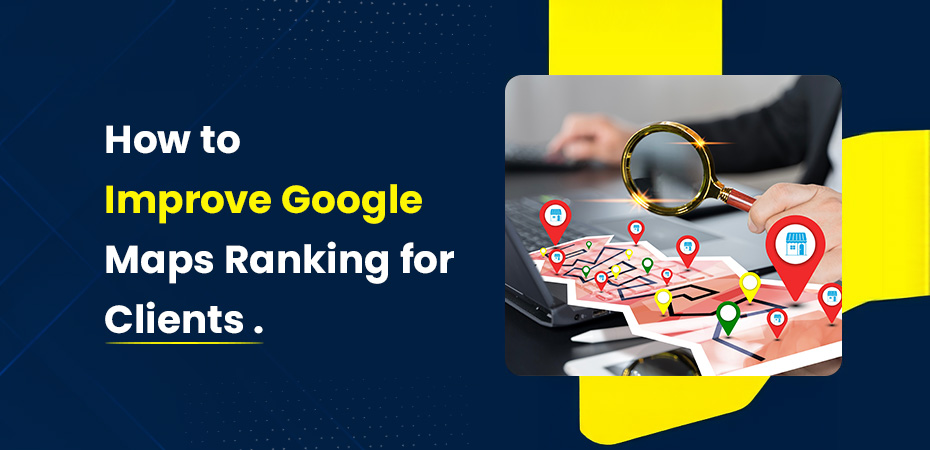How to Improve Google Maps Ranking for Clients



As a digital marketing agency, you’re constantly looking for ways to drive better visibility and foot traffic for your clients, especially those with physical locations. One of the most powerful ways to do that is through Google Maps SEO — a critical element of local digital strategy.
At White Label SEO Providers, we specialize in helping agencies like yours deliver white-labeled, scalable SEO solutions that get local businesses noticed. In this guide, we’ll walk you through exactly how to rank higher in Google Maps, tailored specifically for marketing teams and SEO professionals serving local businesses.
Let’s break it down step by step.
Why Google Maps Rankings Are Crucial for Local Business Success
Local visibility is no longer optional — it’s essential. When users search for a product or service near them, they often find results in what’s called the Google Map Pack (also referred to as the Google Local Pack). These are the top three business listings shown directly under the map on Google search results.
For agencies managing multiple client accounts, understanding Google Maps ranking can lead to significant performance boosts. Consider this:
- About 80% of local mobile searches result in offline purchases.
- Businesses that appear in the Google local map receive far more clicks than those in standard organic listings.
- A well-optimized listing can generate high-intent traffic at no additional cost.
Appearing prominently on Google Maps not only improves your Google rank but also enhances local credibility. Unlike traditional search engine optimization, Google Maps search engine optimization takes into account location, local relevance, user behavior, and proximity.
This means your agency has an opportunity to help clients outrank competitors using local SEO analysis by optimizing key elements that affect their Google Places ranking.
Explore our guide on local SEO strategies to see how we support agencies in scaling local visibility across multiple clients and regions.
Understanding the Google Maps Algorithm: What Actually Affects Rankings?
To get businesses to rank in Google Maps, it’s essential to understand what drives Google map SEO.
Google uses three primary factors to determine where a business appears in the seo maps Google results:
1. Relevance
Relevance refers to how well your client’s business profile matches what someone is searching for. This is why selecting the correct business category and using accurate, detailed descriptions are so important.
2. Distance
This factor considers how far the potential customer is from the business location. While you can’t change geography, you can optimize content to rank better in nearby searches.
3. Prominence
Prominence relates to how well-known the business is. Google looks at reviews, citations, backlinks, and even offline reputation indicators. Higher prominence typically means better Google maps ranking.
Understanding these factors helps agencies tailor strategies based on each client’s unique market position and goals. It’s important to note that these signals aren’t weighed equally — for some searches, proximity might matter more, while for others, relevance or authority could take the lead.
Beyond the algorithm, Google also factors in behavioral signals such as clicks, check-ins, and interactions on the Google Business Profile. This means ongoing optimization and user engagement play a big role.
To dive deeper into how search engines evaluate local listings, check out our resource on schema markup for local SEO — a powerful tool for enhancing relevance and authority on the map.
Step-by-Step Blueprint to Rank Higher on Google Maps
So, how do you actually improve Google rank for a client’s business in the map pack? Here’s our proven method at White Label SEO Providers, used successfully across dozens of industries.
1. Claim and Fully Optimize the Google Business Profile (GBP)
This is non-negotiable. Your client’s local business Google Maps visibility starts with a fully claimed and optimized Google Business Profile.
Here’s what to focus on:
- Accurate NAP (Name, Address, Phone Number): Make sure all information matches exactly with the client’s website and other listings.
- Primary and Secondary Categories: Choose one precise primary category (e.g., “Personal Injury Attorney”) and add secondary ones that describe additional services.
- Complete Business Description: Include a keyword-rich but natural summary that covers services, specialties, and service areas.
- Operating Hours: Keep hours updated, especially during holidays.
- Products, Services, and Menu Items: These fields enhance relevance and visibility.
- Attributes: Add relevant features like wheelchair accessibility, payment methods, etc.
By setting up the profile completely and correctly, you’re laying the groundwork for stronger Google Maps search engine optimization results.
2. Add High-Quality, Geotagged Photos
Photos significantly improve engagement and help build trust with local customers.
Use a variety of image types, such as:
- Storefront and interior shots
- Product or service in action
- Team members and behind-the-scenes views
Geotagging photos (embedding location metadata) helps Google understand where the business is and increases local relevance. While geotagging isn’t an official ranking factor, it supports contextual cues in Google’s algorithm.
Aim to upload fresh photos regularly — once or twice a week. Not only does this show activity, but it encourages clicks and interactions, signaling to Google that the listing is active and helpful.
3. Encourage and Respond to Reviews
Reviews are a major driver of Google local map rankings. They influence not only placement in the map pack but also customer decision-making.
Here’s how agencies can help clients get more high-quality reviews:
- Implement automated email or SMS review requests post-purchase.
- Use in-store signage or QR codes linking to the Google review page.
- Train staff to ask satisfied customers for feedback.
Equally important is responding to each review — positive or negative. This shows the business is active, values customer input, and contributes to higher engagement rates.
Be sure to use natural keywords in review responses when appropriate. This can help boost relevance in Google map searches without triggering spam filters.
If you’re interested in helping your clients dominate local search, take a look at our breakdown on how to outrank local competitors using strategic SEO.
Build Local Citations and Ensure NAP Consistency
One of the most overlooked yet powerful strategies to boost map ranking is consistent NAP (Name, Address, Phone Number) citations across the web. For agencies managing multiple clients, citation building provides a scalable, repeatable process to enhance Google Maps optimization without complex implementation.
What Are Citations?
Citations are mentions of a business’s NAP on external websites like directories, business listings, and local chambers of commerce. Think Yelp, Yellow Pages, Facebook, or industry-specific directories.
Here’s how they help:
- Signal legitimacy to Google by confirming business information across trusted sources.
- Improve relevance and trust, key factors in Google’s local algorithm.
- Drive referral traffic and brand visibility.
Agency Tips for Managing Citations at Scale
- Use tools to identify citation gaps and monitor inconsistencies.
- Prioritize authoritative directories in your client’s niche or region.
- Schedule periodic audits to maintain accuracy across all listings.
To streamline this process, you can leverage our full suite of white label SEO services which includes comprehensive citation management — ideal for agencies juggling multiple local SEO accounts.
Earn Local Backlinks That Matter
While many agencies focus heavily on on-page SEO, backlinks remain one of the most powerful ranking signals — even for local search. But not all backlinks are equal, especially when it comes to Google Maps optimization.
Local backlinks — links from websites in the same geographic region — hold more weight in boosting maps SEO performance.
How Agencies Can Secure Valuable Local Links
- Reach out to community blogs, local newspapers, or business associations.
- Sponsor local events or nonprofits and ask for a website mention.
- Write guest posts for regional industry blogs and include your client’s NAP with a link.
As an agency, you can also scale this strategy using templated outreach and custom content strategies. For clients with multiple branches, you can refine your approach further. Learn how to do that with our guide on mastering content for multi-location businesses.
Use Location-Based Content to Improve Google Rankings
Google loves content that is both helpful and locally relevant. Agencies often overlook this tactic, but localized landing pages can drastically improve Google rankings for clients looking to dominate in their city or region.
For example, a dentist in Dallas should have a dedicated service page for “Emergency Dentist in Dallas” instead of just a general service page. This helps match the user’s search intent and signals location relevance to Google.
Local Content Strategy Best Practices
- Create individual pages for each service + location combo.
- Use local landmarks, city names, and zip codes naturally in the content.
- Add embedded Google Maps, customer testimonials from the area, and localized schema markup.
Need help crafting a location-based content strategy that actually ranks? Our team offers in-depth, white-labeled SEO audits to uncover local content gaps and identify what’s needed to climb the map results.
Leverage Google Posts and Messaging Features
Keeping the Google Business Profile fresh with updates is a signal of activity and engagement — both of which help improve visibility.
Google Posts allow you to share promotions, updates, events, or even blog content directly on the listing. This gives you a chance to stand out from competitors in the Google local pack and encourage more clicks.
Best Practices for Google Posts
- Keep posts brief, relevant, and updated weekly.
- Include a call-to-action like “Learn More” or “Call Now.”
- Use UTM parameters to track post performance in analytics.
Don’t forget the messaging feature either — enabling chat allows for quicker customer engagement and further signals relevance and trust to Google.
These activities, while simple, strengthen your client’s presence and improve Google rankings across both Maps and organic local search.
Monitor, Analyze, and Adjust Your Google Maps SEO Strategy
Ranking on Maps isn’t a one-and-done task. Algorithms change, competitors adjust their strategies, and customer behavior evolves. That’s why constant tracking is essential.
Key Metrics to Monitor
- Profile Views and Actions: See how many users call, visit the website, or request directions.
- Keyword Rankings: Track keywords for each service and location combo.
- Review Volume and Rating Trends: Monitor patterns and identify service gaps.
At White Label SEO Providers, we equip agencies with white-labeled dashboards and reporting tools that help track Google Maps SEO performance over time. Whether you’re managing 10 or 100 locations, data is key to long-term success.
If you’re not sure where your client’s listing stands, start with a comprehensive SEO audit — it’s the best way to build a data-driven roadmap for scaling Google Maps ranking.
Conclusion
Agencies that understand how to optimize Google Maps listings are better positioned to deliver fast, measurable ROI for their clients. From citation building to local content strategies and backlink outreach, every step helps push the business higher in the Google Map and win more local leads.
Whether you’re just starting to scale your local SEO services or need help optimizing multiple listings, White Label SEO Providers is here to support you. Explore our complete SEO service packages to see how we help agencies across the U.S. deliver elite-level results under their own brand.
Ready to dominate the local landscape for your clients? Let’s boost those Google Places rankings — together.
Frequently Asked Questions (FAQs)
By optimizing Google Business Profiles, building citations, and earning local backlinks.
It’s the process of optimizing a business listing to appear in local search and map results, driving more visibility and leads.
Yes, both the quantity and quality of reviews are key ranking factors in local search.
Results typically show within 1 to 3 months, depending on competition and optimization level.
Yes, with white label tools and strategies tailored for scalability and performance tracking.